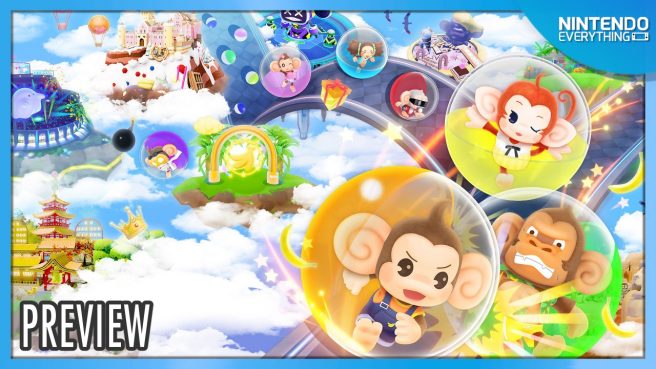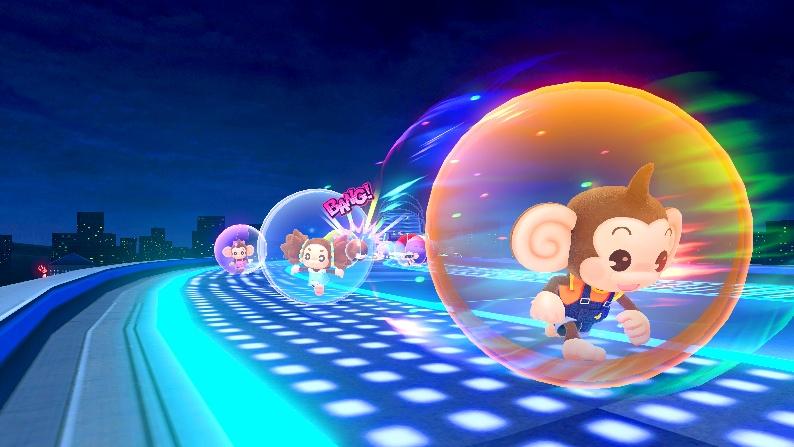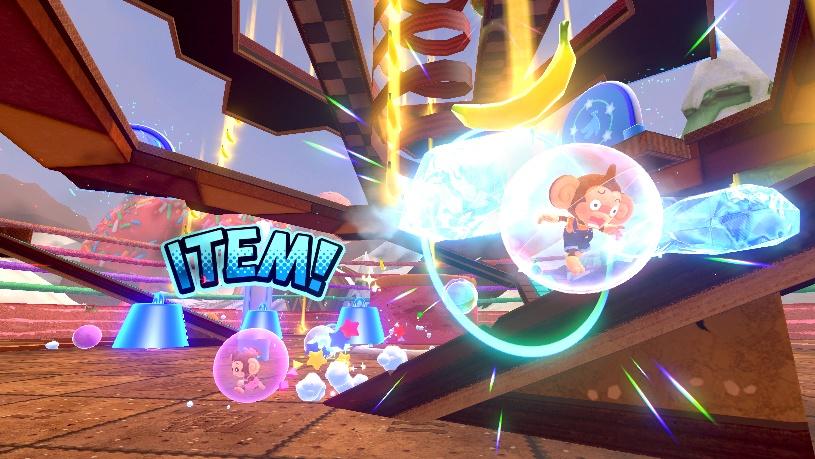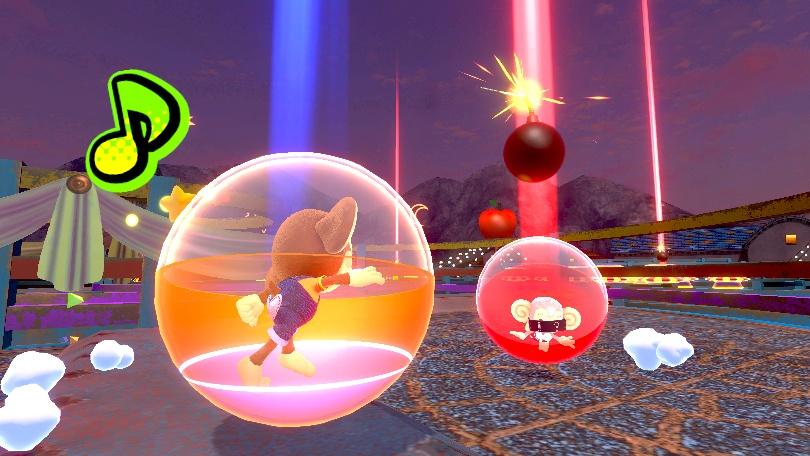[Preview] Super Monkey Ball: Banana Rumble
Super Monkey Ball: Banana Rumble has a relatively complicated road ahead of it. It is the first brand new game in the series in nearly twelve years, and trying to balance its new content on top of reconnecting the series to its roots. Based on my recent one-hour preview, it seems to be living up to the task.
While Banana Rumble introduces many new elements to the formula, at its core it is the exact experience you expect from Super Monkey Ball. That means you are a monkey in a ball, navigating tricky courses by tilting the stage to roll your monkey into the goal. Though the addition of a “Spin Dash” and a 16-player online mode akin to Mario Kart battle modes certainly make this title stand out.
As to be expected the standard Adventure Mode is returning this time around, with 200 new courses in total – all of which are in the classic Monkey Ball style, and rather beautifully themed. In addition, every world has a beginning and ending cutscene that is fully voice-acted with little monkey sounds. It loosely reminded me of the Splatoon language, just not as deep. A game like Super Monkey Ball: Banana Rumble by no means needs to have a story, but the effort SEGA put in here really helps add to the already phenomenal charm the game had. Whether it was the new character Palette, the theming of the worlds, or the cutscenes, the game just exuded charm at every corner of the single-player content.
While the core gameplay remained the same, I found the introduction of a “Spin Dash” really shakes up the gameplay particularly in the story mode. While it shares the iconic name of another one of SEGA’s characters, here it works a little differently than the blue blur’s move of a similar name. Simply pressing a button at any time will make an arrow appear under the monkey, and once released the monkey will charge in that direction. Unlike Sonic who comes to a stop before his Spin Dash, the Monkey Ball version allows you to charge and launch while still in motion. This means it is possible to combine your existing momentum with the Spin Dash to gain some amazing speed. The shortcut potential this unlocks on nearly every level cannot be understated. On many stages the person I was playing with and I would start to lose track of the limited time we had on the demo, simply trying to make some insane shortcut work and finish the stage in less than five seconds. I am excited to see how players vastly better at Super Monkey Ball take advantage of this new movement option.
While versatile, the Spin Dash is also not without its restrictions to keep it a healthy part of the game. Firstly, I found there was an inherent risk and reward to the move. You might be able to make the impressive jump, but staying on the course or slowing your monkey down after gaining so much momentum can be hard. For example, during a race I managed to take a short cut using the Spin Dash but quickly lost control and fell off the map. Another drawback is that the move has a standard recharge time and is not spamable. Each monkey has a different stat on how fast the Dash can recharge, though it never takes more than a couple of seconds. Overall, the Spin Dash seemed to be a rather versatile tool that fit incredibly naturally into the Monkey Ball formula without breaking it.
In addition to Adventure Mode, the game features multiplayer-based Battle Modes. These can be played online or through local wireless, with up to 2 players on the same console and 16 players total in a lobby. The modes also support 4-player split-screen when not connected to a wireless lobby. Any slot not taken up by a human player can be filled in with a bot where desired.
The Battle Modes include; Race, Banana Hunt, Ba-Boom, Goal Rush, and Robot Smashers. Race is pretty straightforward – it is a kart-styler racer in the vein of Mario Kart or Sonic and All-Stars Racing, but with Monkey Ball mechanics. Banana Hunt is much like Mario Kart’s “Coin Runners” with the goal of collecting the most bananas. Ba-Boom is a giant game of hot potato where you try to reach the end of a round without a bomb, touching another player will pass the bomb onto them and vice versa. Goal Runners is a team-based mode with the aim of turning as many goals on the course to the color of your team. Lastly, Robot Smasher is all about trying to use momentum and the new Spin Dash move to crush more robots than the opposing team. Goal Rush and Robot Smashers are team-based games, while the other three are individual-based.
Out of all the Battle Modes, Goal Rush seemed to be the most unique and my favorite to play. Various goal arches with different points are scattered throughout a complex course, and rolling through it claims the goal for your team. If an opposing player manages to roll into the same goal, they will steal the points back for their team. Conversely, if a player rolls into a goal already in their team’s control, they will gain additional points for the team. At the end of the time limit, the points a team currently has are tallied up much in the style of a Splatoon Turf War. It’s rather complicated to explain with words like this, but it is easy to grasp when playing.
The map I played Goal Rush on was shaped sort of like a bonus stage from Sonic the Hedgehog 2, and it created the perfect atmosphere of chaos. Having 16 monkeys barreling down a half-pipe, all smacking each other around trying to get the goals with the higher scores was just hilariously fun in a way I did not expect out of the mode at all. The other stages looked much more complex and dynamic, but something about this simple half-pipe decline just was incredibly entertaining.
Overall the Battle Modes were a little hit or miss. Race in particular had some balancing issues that made things difficult. If you fall off the map during a race you will always respawn at the last checkpoint, and this was often particularly brutal. Maybe I just had bad luck, but at one point I was in first place, and falling off the map caused me to plummet into a distant last. It’s not that the game is hard, but that one punishment was so harsh that I spent the rest of the game playing catch-up. Additionally, all the items across each mode were rather underwhelming, I mostly just found myself spamming them whenever it seemed convenient and I never gained a good grasp of what items there were and what they did across the session with the Battle Mode. Though, accidently eating through so much time attempting short cuts in Adventure Mode might have affected this.
Admittedly, I have not played a Monkey Ball game since the 3DS, and haven’t really got into one since Super Monkey Ball 2, so I went into this demo expecting very little out of Banana Rumble. But I was beyond pleasantly surprised – the new mechanics were both interesting and naturally implemented, the Battle Modes were mostly fun, and the game exuded charm at every second of my hour-long demo. I will be very interested to see how the final product turns out when it releases on June 25.



